
The Rhône wine region in Southern France is situated in the Rhône valley and produces numerous wines under various Appellation d'origine contrôlée (AOC) designations. The region's major appellation in production volume is Côtes du Rhône AOC.

A rosé is a type of wine that incorporates some of the color from the grape skins, but not enough to qualify it as a red wine. It may be the oldest known type of wine, as it is the most straightforward to make with the skin contact method. The pink color can range from a pale "onionskin" orange to a vivid near-purple, depending on the grape varieties used and winemaking techniques. Usually, the wine is labelled rosé in French, Portuguese, and English-speaking countries, rosado in Spanish, or rosato in Italian.

Banyuls is a French appellation d'origine contrôlée (AOC) for a fortified apéritif or dessert wine made from old vines cultivated in terraces on the slopes of the Catalan Pyrenees in the Roussillon county of France, bordering, to the south, the Empordà wine region in Catalonia in Spain.

Collioure is an Appellation d'Origine Contrôlée (AOC) for French wines situated around the town of Collioure in the Roussillon wine region of France. Red, rosé and a few white wines are produced-the reds from Grenache noir, Mourvèdre, Syrah, Carignan and Cinsaut grapes; the white are made from a blend of Grenache blanc and Grenache gris. The boundaries of the AOC are identical with the Banyuls AOC as many of the grapes grown in Collioure are destined for use in the fortified Vins doux naturels of the region. The grapes that do not get used for Banyuls are then produced as non-fortified still wines under the Collioure AOC.
Côtes du Roussillon is an Appellation d'Origine Contrôlée for wines made in the Roussillon wine region of France. It is the least selective AOC in the Roussillon region. In 2002, 21,048,500 litres of Côtes du Roussillon were produced, 68% red, 28% rosé and 4% white. Grenache is the dominant variety in Red and Rosé. According to the AOC rules, however, red wines must be made with at least three varieties of grapes. The total of the two main variety grapes should not make more than 90% of the blend, and there must not be more than 60% of Carignan in it.
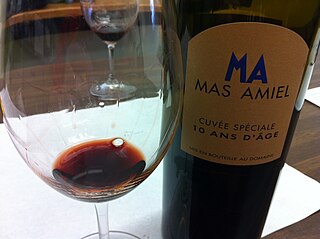
Maury is an Appellation d'Origine Contrôlée (AOC) for fortified vin doux naturel wines made in the Roussillon wine region of France. Almost all wines are red, made from at least 75% Grenache noir (Garnacha). Other permitted grapes are Grenache blanc, Grenache gris, Macabeu (Macabeo), Malvoisie du Roussillon (Tourbat), Syrah, Muscat and other local varieties. Although the grapes are different, they are used and marketed very much like port. It is made in the communes of Maury, Saint-Paul-de-Fenouillet, Lesquerde, Tautavel and Rasiguères. The AOC was granted in 1936.
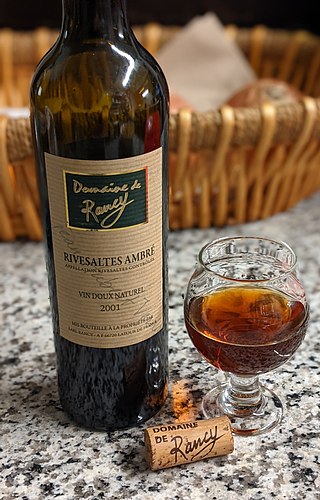
Rivesaltes is an appellation d'origine contrôlée (AOC) for naturally sweet, fortified wines. The name refers to both a production region within Languedoc-Roussillon in southern France, and the style of sweet wines produced there.

Côtes du Rhône is a wine-growing Appellation d'Origine Contrôlée (AOC) for the Rhône wine region of France, which may be used throughout the region, also in those areas which are covered by other AOCs. In a limited part of the region, the Côtes-du-Rhône Villages AOC may be used, in some cases together with the name of the commune.

Côtes-du-Rhône Villages is a French wine Appellation d'Origine Contrôlée (AOC) in the southern Rhône wine region of France. Red, white and rosé wine are all produced within the appellation. The quality is superior to the generic Côtes-du-Rhône AOC, but below more specific appellations such as Châteauneuf-du-Pape AOC and Vacqueyras AOC. Côtes-du-Rhône Villages is the second largest appellation in the Rhône, only surpassed in size by Côtes-du-Rhône AOC.
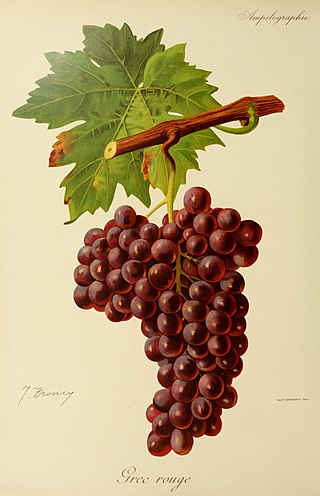
Barbaroux is a pink-skinned French wine grape variety grown in southeastern France. It is a permitted variety in the appellation d'origine contrôlée wine of Cassis in Provence as well as in the Ajaccio region of Corsica. While it is sometimes known under the synonym "Barbarossa", DNA profiling has shown the Barbaroux grown in Provence is distinct from the Barbarossa vines grown in Liguria and Piedmont and is likely unrelated to all Italian Barbaross vines. There is also debate among ampelographers about whether the Barbaroux vines in Provence and Corsica are the same grape or separate Vitis vinifera varieties.
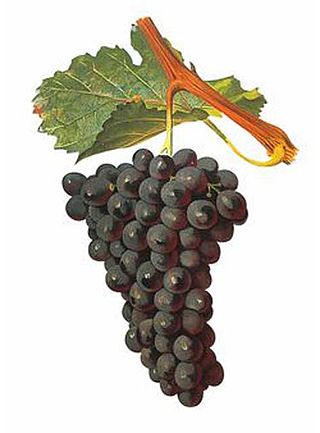
Terret noir is a dark-skinned French wine grape variety grown primarily in the Rhône valley region of France. It is a mutation of the old Vitis vinifera vine Terret. It is a permitted blending grape for Châteauneuf-du-Pape. Like the related Terret gris and Terret blanc, the vine tends to bud late and grow vigorously. Terret noir produces a light color wine that is perfumed and tart.
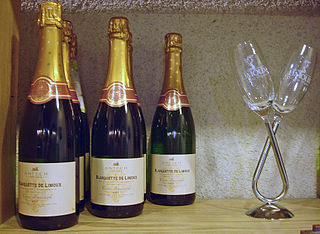
Limoux wine is produced around the city of Limoux in Languedoc in southwestern France. Limoux wine is produced under four Appellation d'origine contrôlée (AOC) designations: Blanquette de Limoux, Blanquette méthode ancestrale, Crémant de Limoux and Limoux, the first three of which are sparkling wines and dominate the production around Limoux. The main grape of the region is the Mauzac, locally known as Blanquette, followed by Chardonnay and Chenin blanc. In 2005, the Limoux AOC was created to include red wine production consisting of mostly Merlot. Wine historians believe that the world's first sparkling wine was produced in this region in 1531, by the monks at the abbey in Saint-Hilaire.

Corbières is an Appellation d'origine contrôlée (AOC) for wine in the Languedoc-Roussillon, France, and it is this region's largest AOC, responsible for 46 per cent of the region's AOC wine production in 2005. Red wine dominates the production in Corbières with almost 95 per cent, with 3.5 per cent rosé wine and 2 per cent white wine making up the balance. Carignan is the most common grape variety. The AOC was created in 1985, covers 13,500 hectares of vineyards and produces an average of 554,000 hectoliters of wine per year, corresponding to 74 million bottles.

Provence (Provençal) wine comes from the French wine-producing region of Provence in southeast France. The Romans called the area provincia nostra, giving the region its name. Just south of the Alps, it was the first Roman province outside Italy.

Cabrières is a commune in the Hérault department in southern France. It is noted for its flourishing wine industry.

Beaumes de Venise is an appellation of wines from the eastern central region of the southern half of the Rhône Valley. It produces wines of two distinctly different types:

Corsica wine is wine made on the Mediterranean island of Corsica. Located 90 km west of Italy, 170 km southeast of France and 11 km north of the island of Sardinia, the island is a territorial collectivity of France, but many of the region's winemaking traditions and its grape varieties are Italian in origin. The region's viticultural history can be traced to the island's settlement by Phoceans traders in 570 BC in what is now the commune of Aléria. In the 18th century, the island came under the control of France. Following the independence of Algeria from French rule, many Algerian Pieds-Noirs immigrated to Corsica and began planting vineyards. Between 1960 and 1976 the vineyard area in Corsica increased fourfold. In 1968, Patrimonio was established as Corsica's first Appellation d'origine contrôlée (AOC). Today, Corsica has nine AOC regions including the island-wide designation Vin de Corse AOC. The majority of the wine exported from Corsica falls under the Vin de pays designation Vin de Pays de l'Île de Beauté. The three leading grape varieties of the region are Nielluccio (Sangiovese), known as the spice wine of France, Sciacarello and Vermentino.
Terret blanc is a white French wine grape variety growing primarily in the Languedoc-Roussillon region of southern France. It is a mutation of the Terret vine that also spawned the dark skinned Terret noir and light-skinned Terret gris varieties.

Brun Fourca is a red French wine grape variety that once grew widely throughout Provence and Southwest France but is now limited to small plantings within the Palette Appellation d'Origine Contrôlée (AOC).
Téoulier is a red French wine grape variety found in south east France. Ampelographers speculate that the grape may have originated around the Provençal town of Manosque due to the town's close association with several synonyms of the variety. For most of the 20th century, plantings of Téoulier have steadily declined and today is rarely found.

















